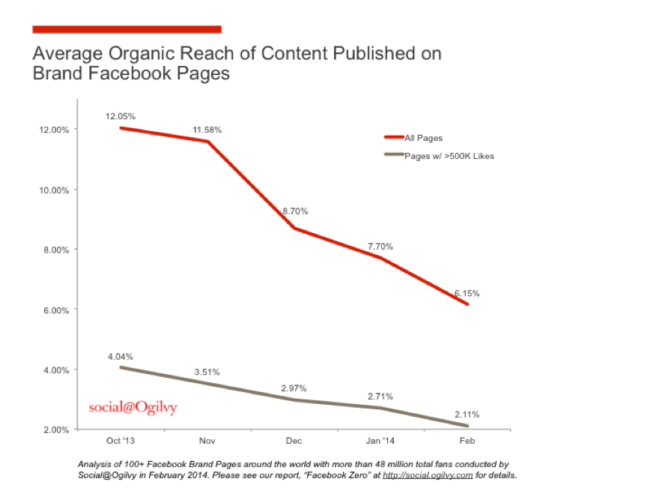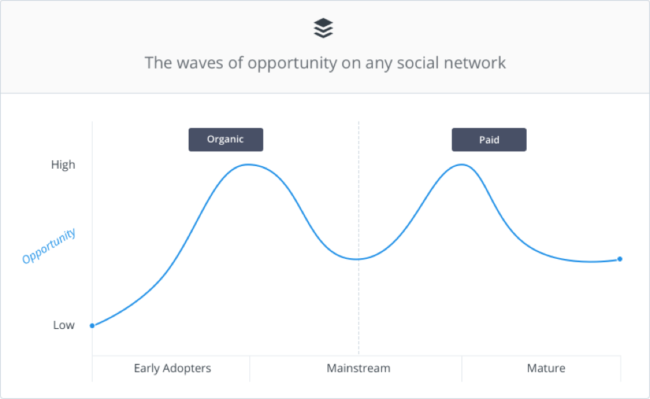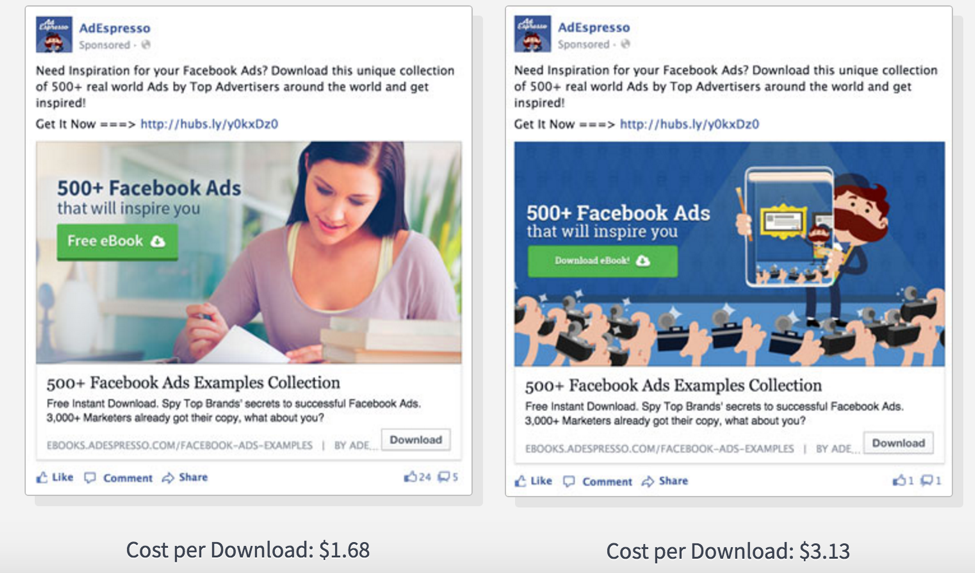
Facebook wears many hats. It does everything, and is everything. It’s where we turn to celebrate many important life milestones, share our lives with our friends, organize events, consume media and much, much more. But for marketers, it’s an advertising tool.
Social media marketing has changed a great deal over the past few years. One of the biggest changes is Facebook’s shift away from organic reach into a paid marketing channel.
If you manage a Facebook Page, I’m sure you’re familiar with this subject, and you’ve probably noticed a sharp drop in the number of people who are seeing and interacting with your content organically.
As a marketer, this change has been tough to stomach. It’s now much harder to reach your audience than it was a few years ago. And with recent updates that Facebook is, again, shifting its algorithm to focus on friends and family, it’ll be harder still to reach people who are already fans of your page.

Before we dive into why the plight of organic reach is a good thing, let’s first take a look at what brought along this decline in the first place.
Want more awesome content to help you crush your marketing goals?
Understanding how social reach is declining
In 2014, Social@Ogilvy released its much-cited report, “Facebook Zero: Considering Life After the Demise of Organic Reach.”
In the report, Ogilvy documented the harsh decline of organic reach between October 2013 and February 2014. In that short period of time, organic reach dropped to around 6% for all pages, and for large pages with more than 500,000 likes, the number was just 2%.

Based on this data, a Facebook Page with around 20,000 fans could expect fewer than 1,200 people to see its posts, and a page with 2 million fans would, on average, reach only 40,000 fans.
The reasoning behind this change from Facebook’s perspective is twofold, as Facebook’s VP of Advertising Technology, Brian Boland, explained in a blog post.
The first reason for the decline in organic reach is purely the amount of content being shared to Facebook. Advances in smartphone technology means we can now create and share this content with just a few swipes of the finger or taps on a screen. More and more of our friends and favorite brands are also active on the platform, meaning competition for attention is higher. Boland explains:
There is now far more content being made than there is time to absorb it. On average, there are 1,500 stories that could appear in a person’s News Feed each time they log onto Facebook. For people with lots of friends and Page likes, as many as 15,000 potential stories could appear any time they log on.
The second reason for the decline in organic reach on Facebook is how the News Feed works. Facebook’s number one priority is to keep its 1.5 billion users happy, and the best way to do that is by showing only the most relevant content in their News Feeds.
Of the 1,500+ stories a person might see whenever they log onto Facebook, News Feed displays approximately 300. To choose which stories to show, News Feed ranks each possible story (from more to less important) by looking at thousands of factors relative to each person.
To a marketer, this may feel like a negative, but it’s actually a good thing, because what we’re left with now is a far more powerful marketing tool than we had when reach was free.
Let me explain…
Why the decline of organic reach is a good thing
When a social network first achieves mainstream popularity (think Facebook circa 2009, Instagram in 2014-15, Snapchat in 2016) organic reach rules the roost. As a marketer, it’s all about figuring out what content your audience craves and giving it to them.
Then, we hit a peak, and suddenly the social network all but transforms into a pay-to-play platform — bringing with it another huge marketing opportunity. At Buffer, it’s something we like to call The Law of the Double Peak:

Facebook hit the organic peak in 2014, and since then reach has declined to a point where it’s almost at zero now. But, on the other hand, we’re left with a far more powerful advertising tool than we had before.
It’s also important to remember that before social media — with print, radio, TV, banner ads, direct mail or any other form of advertising — there was no such thing as organic reach. You couldn’t create a piece of content and get it seen by thousands (even millions) with no budget.
Facebook, now, is probably one of the most cost-effective digital ad products we’ve ever seen. It’s the best way to reach a highly targeted audience and drive awareness about your product or service, and probably an even better marketing channel than it was back in 2012 when organic reach hit its peak.
4 ways to maximize the paid marketing opportunities on Facebook
Once you’re over the fact that not everyone on Facebook gets to discover your brand for free anymore…
1. Ensure your ads are relevant
With more than 3 million advertisers all competing for attention in more than a billion users’ News Feeds, Facebook uses what’s called an ad auction to deliver ads.
The ad auction pairs individual ads with particular people looking for an appropriate match. The social network’s ad auction is designed to determine the best ad to show to a person at a given point in time. This means a high-quality, hyper-relevant ad can beat an ad that has a higher advertiser bid, but is lower quality and less relevant.
The two major factors you need to work on to ensure Facebook sees your ad as relevant are your targeting and ad creative.
For example, if you’re targeting a broad audience such as men and women, ages 18–25, living in the United Kingdom, chances are your ad may not be relevant to every person. However, if you were to break your audience down into smaller, more specific groups your message may be more relevant (and therefore successful).
2. Test different messages and creative
There are endless opportunities for testing on Facebook Ads: titles, texts, links, images, age, gender, interests, locations and so on.
The image is the first thing people see when your ad shows up in their News Feed. It’s what grabs their attention and makes them stop and click, which means it’s essential to get the image right. Though, you probably won’t hit the nail on the head first time ‘round. Thankfully, Facebook allows you to upload multiple images for each advert and optimizes to display best performing ones.
Your creative can have a huge difference when it comes to conversions. AdEspresso recommends coming up with at least four different Facebook Ad variations and then testing each one. For example, you might test two different images with two different copy texts (2 images x 2 texts = 4 variations).
AdEspresso also found that creative with a picture of a person performs far better:

When you create ads, plan out a number of variations — changing copy, images and CTAs in order to discover what works best for each audience you’re targeting.
Want more awesome content to help you crush your marketing goals?
3. Be specific with your content
Combining the first two points above, targeting to a specific segment using creative that is specifically built for that target audience is incredibly powerful.
Many businesses have a range of customers, all with slightly different needs. For each customer your business is targeting, jot down as much information as you can about them and try to form a few customer personas to create specific ads for.
Then, with your target personas in place, think about how you can use Facebook Ads to target each individual group. This could mean creating an ad set for each group and testing different images and copy within your ads to see what works best for each group.
By tailoring ads to specific personas, you can vastly improve your advert’s relevancy and also serve the needs of your customer better.
4. Pay attention to real metrics
With social media, it can be easy to fall into the trap of measuring only soft metrics — the things that don’t correlate directly with sales or revenue growth, but can still be good indicators of performance. On Facebook, this means things such as Likes, Comments and Shares.
When it comes to paid marketing channels, like Facebook Ads, it’s important to have some solid goals in mind and pay attention to the metrics that translate into your ultimate goal. For example, having a post receive a few hundred Likes or a high engagement rate could be seen as success, but that’s probably not the ultimate goal of your campaign.
Paid advertising on Facebook is a lot like paid-for marketing has always been. For 90% the end goal is sales or, for larger companies, brand awareness. And with paid-for ads you’ll want to be a little stricter with yourself when it comes to measurement. That’s not to say ALL advertising on Facebook must be purely focused on selling — that strategy likely wouldn’t work — but certainly any specific advertising campaigns should be focused on increasing your bottom line.
How do you use Facebook?
I’d love to hear your thoughts on the evolution of Facebook as a marketing channel. How have your strategies changed over recent years? Are you one of the 3 million businesses who advertise on the platform? I’d love to hear your learnings and perspectives too.
Thanks for reading! And I’m excited to join the conversation in the comments.
